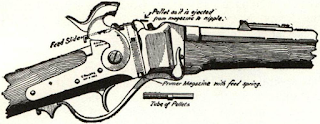Among Sharps Rifle Manufacturing Company
Palmer decided to go the late Colonel Colt not one,
General W. T. Sherman; Lieutenant General Sheridan; Major
Typical of the sentiments of all these officers were
On September 12, , approximately 26V2 months
In addition to Sharps rifles purchased from wholesalers, General Dyer ordered 150 on December 1,
, at a low price of $38; Colonel William A.
In spite of the limited success of these primers, there
No. 2270. SHARP’S Civil War COFFEE MILL
Rare Sharps percussion revolver using tip-up barrel like
Who ever the Navy man or Marine was who owned
Though Palmer claimed he manufactured only for
19, and Spies, Kissam & Co., 50. Wm. Read & Son
Apparently Palmer did not deprive the commercial
Palmer decided to go the late Colonel Colt not one,
General W. T. Sherman; Lieutenant General Sheridan; Major
Typical of the sentiments of all these officers were
On September 12, , approximately 26V2 months
In addition to Sharps rifles purchased from wholesalers, General Dyer ordered 150 on December 1,
, at a low price of $38; Colonel William A.
TO CHARGE THE LOCK WITH “SHARPS’ PRIMES,”
In spite of the limited success of these primers, there
No. 2270. SHARP’S Civil War COFFEE MILL
Rare Sharps percussion revolver using tip-up barrel like
Who ever the Navy man or Marine was who owned
Though Palmer claimed he manufactured only for
19, and Spies, Kissam & Co., 50. Wm. Read & Son
Apparently Palmer did not deprive the commercial



Comments
Post a Comment